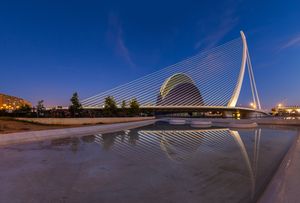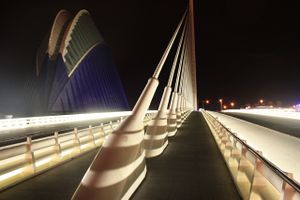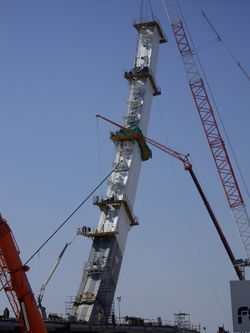جسر أسوت دى لور
Assut de l'Or Bridge (Serreria Bridge) Pont de l'Assut de l'Or | |
|---|---|
 Side view of the Assut de l'Or Bridge with L'Agora in background | |
| Coordinates | 39°27′17.3″N 00°20′58.7″W / 39.454806°N 0.349639°W |
| Crosses | حدائق توريا (قاع نهر توريا السابق) |
| Locale | بلنسية، اسبانيا |
| Characteristics | |
| Design | cable-stayed bridge |
| Total length | 180 metres |
| Height | 125 metres (making it the highest point of the city) |
| No. of spans | one with 29 cable stays |
| History | |
| المعماري | سانتياگو كالاتراڤا |
| تكلفة الإنشاء | 59.9 million Euros |
| اِفتـُتـِح | 12/12/2008 |
| الموقع | |
 | |
جسر أسوت دى لور (Valencian: Pont de l'Assut de l'Or, Spanish: Puente de l'Assut de l'Or؛ إنگليزية: Assut de l'Or Bridge) هو جسر مشدود بالكابلات أبيض رائع مقام على عمود واحد في بلنسية (اسبانيا)، صممه المهندس المدني والمعماري البلنسي سانتياگو كالاتراڤا، واكتمل انشاؤه في ديسمبر 2008. الاسم l'Assut de l'Or يعني سد الذهب ويشير إلى سد كان يوجد في السابق بالقرب من ذلك المكان - إلا أنه يُعرف محلياً بإسم El Jamonero (معلـَّقة لحم الخنزير) أو puente del arpa (جسر القيثارة.) وكان يُدعى Serreria Bridge من قِبل مصممه، سانتياگو كالاتراڤا.[1]
الموقع
The bridge[2] (crossing the Turìa Gardens) is located in central Valencia, Spain in its City of Arts and Sciences[3] complex, which also includes a science museum (Museo de las Ciencias Principe Felipe[4]), a covered plaza for concerts and sporting events (L'Àgora[5]), the 3rd largest aquarium in the world (L'Oceanogràfic[6]), a multifunctional arts complex and opera house (Palau de les Arts Reina Sofia[7]) and, planetarium and Imax (L'Hemisfèric[8])
التصميم
The design of the bridge is a variant of Santiago Calatrava's pioneering 1992 design of a cantilever spar cable-stayed bridge in Seville, Spain. In the Serreria bridge, the pylon is curved backward (angle of the pylon was determined by an analysis of the counter forces against the cable stays) and also back-stayed to concrete counterweights in the roadway. The aesthetic effect of the Serreria bridge arises in part from the curved pylon and the 29 parallel cables supporting the bridge deck, accented at night by spot lighting of the cables and the pylon. The bridge deck has two carriageways, three lanes each for cars and one additional lane for a tramway, and another for pedestrian and cycle traffic, this last along the middle spine of the deck by the cable stays. Although the parallel cables and curved pylon are essentially in one vertical plane (see photos of the cables), because of the changing curvature of the pylon, like that of a planar spiral curve form, there might be an optical illusion when the bridge is viewed from the side (e.g., see side view photo above) that the pylon and the cables may appear to be not planar.
انظر أيضاً
- Samuel Beckett Bridge in Dublin, Ireland, in which the forward curved pylon is also back stayed
- The Erasmusbrug in the Netherlands, another single pylon cable-stayed bridge in which the pylon is back stayed
الهامش
- ^ Calatrava, Santiago. "Serreria Bridge". calatrava.com. Retrieved 3 June 2016.
- ^ Info Loko site[dead link].
- ^ Info loko site on City of Arts and Sciences.
- ^ Info loko site on Museum of the Sciences.
- ^ Infoloko site[dead link] on Agora.
- ^ Info loko site, on aquarium.
- ^ info loko site on palace of sciences.
- ^ info loko site on planetarium.
وصلات خارجية
- Pages using gadget WikiMiniAtlas
- Articles with dead external links from October 2016
- Short description is different from Wikidata
- Coordinates on Wikidata
- Infobox mapframe without OSM relation ID on Wikidata
- Articles containing إنگليزية-language text
- Pages using Lang-xx templates
- Bridges in the Valencian Community
- جسور اكتملت في 2008
- منشآت سانتياگو كالاتراڤا
- مباني ومنشآت في بلنسية
- Transport in the Valencian Community
- معالم سياحية في بلنسية
- صفحات مع الخرائط

